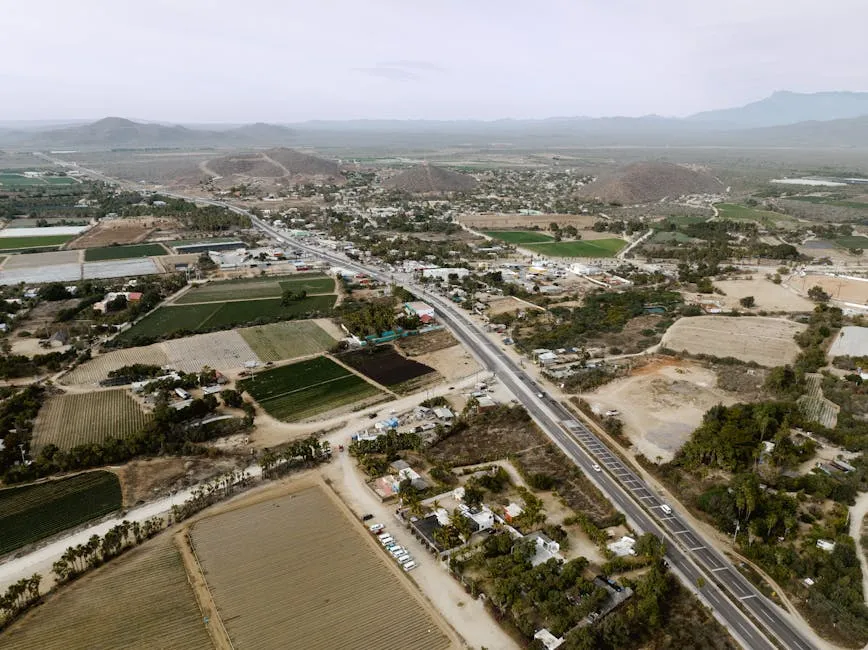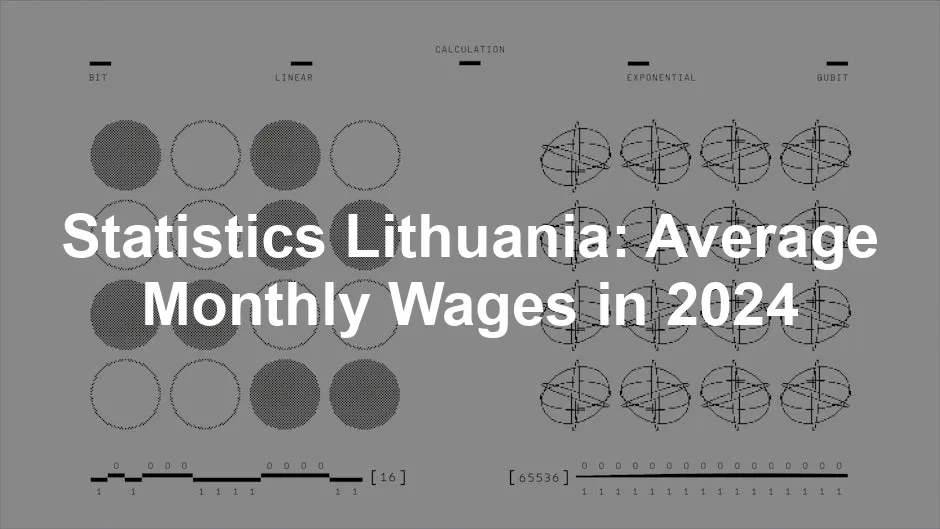Introduction
Lithuania’s economy in 2024 is like a well-oiled machine, humming along with impressive growth! As the country embraces technological advancements and a vibrant service sector, the average monthly wage has taken a notable leap. Understanding average monthly wages is crucial for job seekers, employers, and policymakers alike. For job seekers, these figures can dictate career choices. Employers need to remain competitive to attract talent. Policymakers, on the other hand, must ensure fair compensation that reflects economic realities.
In this article, we will tackle several key themes. First, we’ll explore wage trends that reveal how salaries have shifted over time. Next, we’ll discuss regional disparities that showcase how location influences earning potential. Additionally, we’ll look at industry-specific salaries, highlighting which sectors are the most lucrative. Finally, we will examine the impact of recent economic policies on wages in Lithuania.
Speaking of economic realities, if you’re looking for a solid read that dives into the intricacies of business and innovation, check out The Lean Startup by Eric Ries. This book is a game changer for entrepreneurs aiming to minimize risks and maximize their chances of success. It’s like having a cheat code for starting a business!

The Economic Context of Lithuania in 2024
Lithuania’s economic landscape in 2024 is characterized by resilience. The nation has enjoyed steady GDP growth, buoyed by robust sectors such as IT, manufacturing, and services. GDP growth rates hover around 3% this year, reflecting a thriving economy that’s attractive for both local and foreign investments.
Inflation, however, remains a concern. Currently, inflation rates are approximately 2%, with careful monitoring required to prevent any adverse effects on purchasing power. This balance between growth and inflation is critical, as it directly influences wage negotiations and labor market dynamics.
Global economic trends also play a significant role in shaping Lithuania’s wages. For instance, the demand for skilled labor in technology and healthcare sectors is rising, thanks to international investments. This surge leads to higher salaries in these industries, often outpacing other sectors.
As we peel back the layers of Lithuania’s economic context, it becomes evident that average monthly wages are a reflection of broader economic health. By understanding these indicators, individuals and businesses can make informed decisions that align with the country’s evolving landscape. If you’re curious about how these dynamics play out on a personal level, you might enjoy The Power of Habit by Charles Duhigg. It helps you understand how habits shape our lives and can be a powerful tool in navigating career decisions.

In summary, Lithuania’s economy is flourishing, but the nuances of wage dynamics are intricate. The interplay of GDP growth, inflation, and global trends will continue to shape the earnings landscape for years to come. As we progress in this exploration, let’s take a closer look at the average monthly wages to see how they stack up in 2024!
Average Monthly Wages in Lithuania (2024)
As of 2024, the average gross monthly salary in Lithuania stands at approximately €2,100. This figure reflects a steady increase from previous years, highlighting a positive trend in wage growth across various sectors. For context, in 2023, the average gross monthly salary was around €1,900, marking a significant boost in earnings for many workers. The upward trajectory suggests that Lithuania’s economy is continuing to thrive, driven by sectors such as IT, healthcare, and manufacturing.
It’s essential to understand the difference between gross and net salaries. Gross salary refers to the total amount before any deductions, while net salary is what employees take home after taxes and other deductions. In Lithuania, personal income tax rates generally hover around 20% for most workers, with higher earners facing a rate of 32% on amounts exceeding €7,520.50 monthly. Thus, if we consider a gross salary of €2,100, the net salary would likely fall around €1,680, depending on individual circumstances and potential deductions.

The average salary isn’t uniform across the board. It varies significantly based on industry and region. For instance, professionals in the IT sector can earn between €2,500 and €4,500, reflecting the high demand and specialized skills required. In contrast, manufacturing jobs typically offer salaries ranging from €1,200 to €2,000, which, while lower, still represents a respectable income in the context of Lithuania’s living costs.
If you’re interested in a broader understanding of how finance works and want to make your money work for you, consider reading The Intelligent Investor by Benjamin Graham. This classic book on investing is essential for anyone looking to secure their financial future and navigate the complexities of the market.
Regional disparities also play a crucial role in shaping salary averages. Urban centers like Vilnius and Kaunas generally present higher wages compared to rural areas, where economic activities and job opportunities might be limited. In Vilnius, for example, the average salary can reach up to €2,500, while in rural regions, it might hover around €1,500.

Comparing average wages from previous years helps illuminate growth trends. For instance, the average salary in 2022 was approximately €1,700. The increase to €2,100 in 2024 shows a clear trend of wage growth, driven by a robust economy and rising demand for skilled labor. This rise is partly attributed to the government’s adjustments to the minimum wage, which increased by 10% in 2024, setting the new minimum at €924 per month. Such shifts help lift the overall wage structure, positively impacting the average salary figures.
In summary, as Lithuania continues to develop economically, understanding average monthly wages becomes increasingly important. For job seekers, these figures can influence career decisions, while employers must remain competitive to attract talent. Policymakers can use this data to ensure fair compensation practices across the board. As we look ahead, it’s clear that the average monthly wages in Lithuania are not just numbers; they represent the changing landscape of work and economic vitality in the country.
The average monthly wages in Lithuania reflect the overall economic growth and are vital for job seekers and employers. statistics lithuania average monthly wages lithuania 2024
Breakdown of Average Wages
By Sector
In Lithuania, salaries can vary dramatically across different sectors. Here’s a quick overview of what you can expect in 2024:
- IT and Technology: Professionals in this industry can earn between €2,500 to €4,500 monthly. This range reflects the high demand for skilled tech workers and the competitive nature of the industry. If you’re a coder or a software developer, this is your golden ticket!
- Healthcare: Average salaries in healthcare hover around €2,000 to €3,800. Doctors, nurses, and specialists play crucial roles in society, and their compensation reflects that responsibility. It’s a rewarding field, both emotionally and financially.
- Manufacturing: Here, wages range from €1,200 to €2,000. While not as high as tech or healthcare, manufacturing jobs still provide a decent standard of living. These roles are vital to Lithuania’s economy, keeping the wheels turning, quite literally!
- Education: Teachers and educators can expect average salaries of about €1,300. While this might not make you a millionaire, the satisfaction of shaping young minds is priceless. Plus, summer vacations aren’t too shabby either!

And if you’re looking to improve your personal effectiveness, consider grabbing a copy of The 7 Habits of Highly Effective People by Stephen R. Covey. This book is a fantastic guide to personal and professional growth, helping you to set your priorities straight and achieve your goals!
By Region
The geographical landscape of Lithuania also significantly influences wage disparities. Urban centers like Vilnius, Kaunas, and Klaipėda tend to offer higher salaries than rural areas. Let’s break it down:
- Vilnius: The capital city leads the pack, where average salaries can reach up to €2,500. With its bustling economy and vibrant job market, Vilnius is a hotspot for career opportunities.
- Kaunas: Known for its rich heritage, Kaunas offers salaries ranging from €1,800 to €3,000. This city is rapidly growing, attracting businesses and workers alike.
- Klaipėda: Salaries here can range from €1,600 to €2,800. As a port city, Klaipėda benefits from maritime trade, contributing to its economic landscape.
- Rural Areas: Unfortunately, rural regions lag behind, with average wages typically between €1,000 and €1,500. While the cost of living is lower, the job market can be limited, which may not be ideal for everyone.

Understanding these wage differentials helps job seekers and employees negotiate better salaries based on their location and industry. So whether you’re in the tech sector in Vilnius or teaching in a small town, knowing the average wages can empower you in your career journey.
Factors Influencing Wages in Lithuania
Experience: How Levels of Experience Correlate with Salary Increases
In Lithuania, experience plays a crucial role in salary growth. Entry-level positions often come with modest pay, creating a clear pathway for advancement. As employees gain experience, their salaries can increase significantly. For instance, those with two to five years of experience may earn around 32% more than their entry-level counterparts.
As one climbs the career ladder, the rewards become even sweeter. Mid-career professionals typically see pay raises between 6% to 9%, while senior roles can command increases of 10% to 15%. So, if you’re starting your career, keep your eyes on the prize—experience is your best friend in securing a fatter paycheck!

Education: The Impact of Educational Qualifications on Salary Prospects
Education is another key factor influencing wages in Lithuania. Higher educational qualifications often translate to better-paying job opportunities. Statistics show that individuals with tertiary degrees earn significantly more than those with just a high school diploma.
For example, those with a bachelor’s degree can expect around 24% higher salaries compared to their diploma-holding peers. The trend continues with master’s and doctoral degrees, which can yield even better returns. Thus, investing in education can pay off handsomely in the long run. So, if you’re considering further studies, know that your wallet will thank you later!

Industry Demand: How the Growth of Certain Sectors (like IT) Affects Salary Scales
The demand for skilled labor in specific industries has a direct impact on salary scales. In Lithuania, sectors like IT and healthcare are booming. IT professionals often earn between €2,500 and €4,500 monthly, reflecting the high demand for tech talent.
Conversely, sectors such as manufacturing and retail tend to offer lower salaries, generally ranging from €1,200 to €2,000. As more businesses embrace technology and innovation, the skills needed in these high-demand sectors will continue to shape wage trends. It’s a classic case of supply and demand—more demand for certain skills equals higher pay!

Cost of Living: Comparison of Salaries with Living Costs in Different Regions
Understanding the relationship between salaries and the cost of living is essential, especially in a diverse country like Lithuania. Urban centers such as Vilnius and Kaunas boast higher salaries, but they also come with higher living costs.
In Vilnius, for example, the average salary can reach up to €2,500, yet the cost of living, including housing and transportation, can be steep. In contrast, rural areas may offer lower salaries—around €1,500—but the cost of living is also significantly lower.

This means that while a higher salary in a city might sound appealing, it’s essential to consider what that paycheck can actually buy. Balancing salary expectations with living costs is critical for making informed career decisions. If you’re looking to kick back after a long day, why not treat yourself to a Essential Oil Diffuser? It’s a great way to unwind and create a calming atmosphere at home!
In summary, experience, education, industry demand, and the cost of living all intertwine to create the complex landscape of wages in Lithuania. Understanding these factors can help job seekers and employees navigate their career paths effectively.
Future Trends in Salaries
The economic indicators for Lithuania paint a promising picture for wage growth in the coming years. Analysts forecast that average wages will continue to rise, potentially reaching around €2,300 per month by 2025. This growth is largely driven by a combination of increasing demand for skilled labor and a booming technology sector. As companies expand and invest in their workforce, it’s anticipated that salaries will reflect this upward trend.
Foreign investments are a game changer for Lithuania’s salary landscape. With more multinational companies setting up operations in the country, the competition for talent intensifies. Skilled professionals, particularly in IT and healthcare, can expect substantial pay increases. Moreover, advancements in technology are transforming various sectors, leading to the creation of high-value jobs. As companies adopt automation and digitization, roles requiring specialized skills will see salaries soar.

For example, IT professionals may find themselves in a bidding war among employers, which could push salaries higher than the current averages. Additionally, industries that embrace technology are likely to see their wage structures elevated, benefiting employees and the economy overall. If you’re interested in the future of business, you might want to explore Good to Great by Jim Collins. It’s a fantastic read for anyone looking to understand what makes companies thrive!
However, it’s not all sunshine and rainbows. Several challenges could hinder wage growth in Lithuania. Inflation remains a persistent threat, currently hovering around 2%. If inflation continues to outpace wage increases, workers’ purchasing power may stagnate. Furthermore, global economic conditions, such as recessions in key markets, could hinder investments and job creation, leading to a slowdown in wage growth.

Additionally, the labor market faces structural issues, including a skills gap. As industries evolve, not all workers possess the necessary qualifications, which can limit competition and wage growth. Addressing this skills gap through education and training programs will be essential for ensuring that all workers can benefit from the anticipated wage increases.
In summary, while the future looks bright for salary increases in Lithuania, it’s crucial to remain vigilant about the challenges that lie ahead. Monitoring economic indicators and adapting to changing market demands will be vital for both employees and employers. Keeping an eye on technological advancements and foreign investment trends will help gauge the direction of wage growth in this vibrant Baltic nation.
Conclusion
Average monthly wages in Lithuania are on an upward trajectory, driven by robust economic growth, foreign investments, and technological advancements. However, challenges such as inflation and market fluctuations remind us to stay proactive in navigating the ever-evolving job landscape. As we look toward the future, both job seekers and employers must adapt to these changes, ensuring a competitive and fair wage environment that benefits all stakeholders involved.
Continuous monitoring of wage trends and economic conditions will be essential to thriving in this dynamic landscape. By staying informed and proactive, we can embrace the exciting opportunities that lie ahead in Lithuania’s labor market. And while you’re at it, why not gear up for your next adventure with a Portable Phone Charger? It’s a lifesaver for those on-the-go moments!
Please let us know what you think about our content by leaving a comment down below!
Thank you for reading till here 🙂
All images from Pexels




